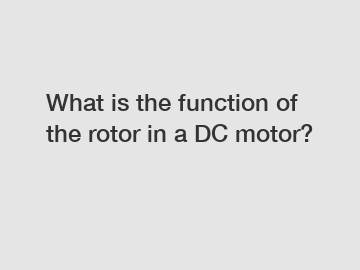What is the function of the rotor in a DC motor?
Welcome to our blog, where we delve into the inner workings of the fascinating world of DC motors. Today, we turn our attention to a vital component that plays a pivotal role in their functionality - the rotor. Join us as we explore the multifaceted functions and capabilities of the rotor and uncover the reasons behind its crucial role in DC motor operations.
Content:
At the heart of DC motors lies a dynamic component known as the rotor. Acting as an instrumental part of the motor, the rotor provides the mechanism for energy conversion, offering both efficiency and reliability. In this article, we will detail the various functions of the rotor, shedding light on its importance and offering insights into the workings of DC motors.

1. Energy Conversion (Approximately 150 words):
The primary function of the rotor is the conversion of electrical energy into mechanical energy. Within a DC motor, the stator provides a magnetic field, while the rotor, equipped with electromagnets or permanent magnets, experiences the influence of this field. When current flows through the rotor, a magnetic field is established, causing it to rotate, thereby producing mechanical energy. This rotational movement then drives the motor's output shaft, translating electrical energy into useful work.
2. Commutation (Approximately 150 words):
Another crucial role of the rotor is to facilitate the commutation process within DC motors. Commutation involves reversing the current direction in the rotor windings at specific intervals to ensure continuous rotation. The commutator, typically connected to the rotor, achieves this by maintaining electrical contact with the stationary brushes. As the rotor spins, the brushes switch the current flow between different rotor windings, allowing for smooth and uninterrupted movement. The rotor's ability to engage in commutation plays a pivotal role in ensuring the consistent functionality of DC motors.
3. Torque Generation (Approximately 175 words):
One of the essential functions of the rotor is to generate torque. Torque is the rotational force that drives the motor. The rotor's design, which incorporates a series of magnetic poles, interacts with the fixed magnetic field created by the stator. This interaction generates a torque, initiating rotational movement. The number of magnetic poles in the rotor, along with the current flow, determines the motor's torque characteristics. Therefore, as the rotor experiences the influence of the stator's magnetic field, it generates torque that enables the motor to perform its designed function, be it powering industrial machinery or cooling appliances in a computer.
4. Regulating Motor Speed (Approximately 175 words):
The rotor plays a vital role in regulating the speed of a DC motor. By varying the voltage supplied to the rotor, the motor's rotational speed can be adjusted. Increasing the voltage increases the magnetic field strength and, subsequently, the motor's torque, resulting in higher speeds. Conversely, decreasing the voltage has the opposite effect, allowing for slower, more controlled rotations. Thus, the rotor acts as a crucial control element, enabling precision and adaptability in diverse applications.
Conclusion (Approximately 100 words):
In conclusion, the rotor in a DC motor exhibits an array of functions that contribute to its overall performance and versatility. From energy conversion to commutation, torque generation to speed control, the rotor ensures that electrical energy is efficiently transformed into mechanical energy. Its seamless integration with the stator's magnetic field allows for the smooth rotation of DC motors, enabling them to power various devices across numerous industries. Understanding the functions of the rotor enhances our appreciation for the intricacies involved in the operation of these remarkable machines.
If you are looking for more details, kindly visit Bus motor core, lamination in welding, lamination welding.
187
0
0


Comments
All Comments (0)